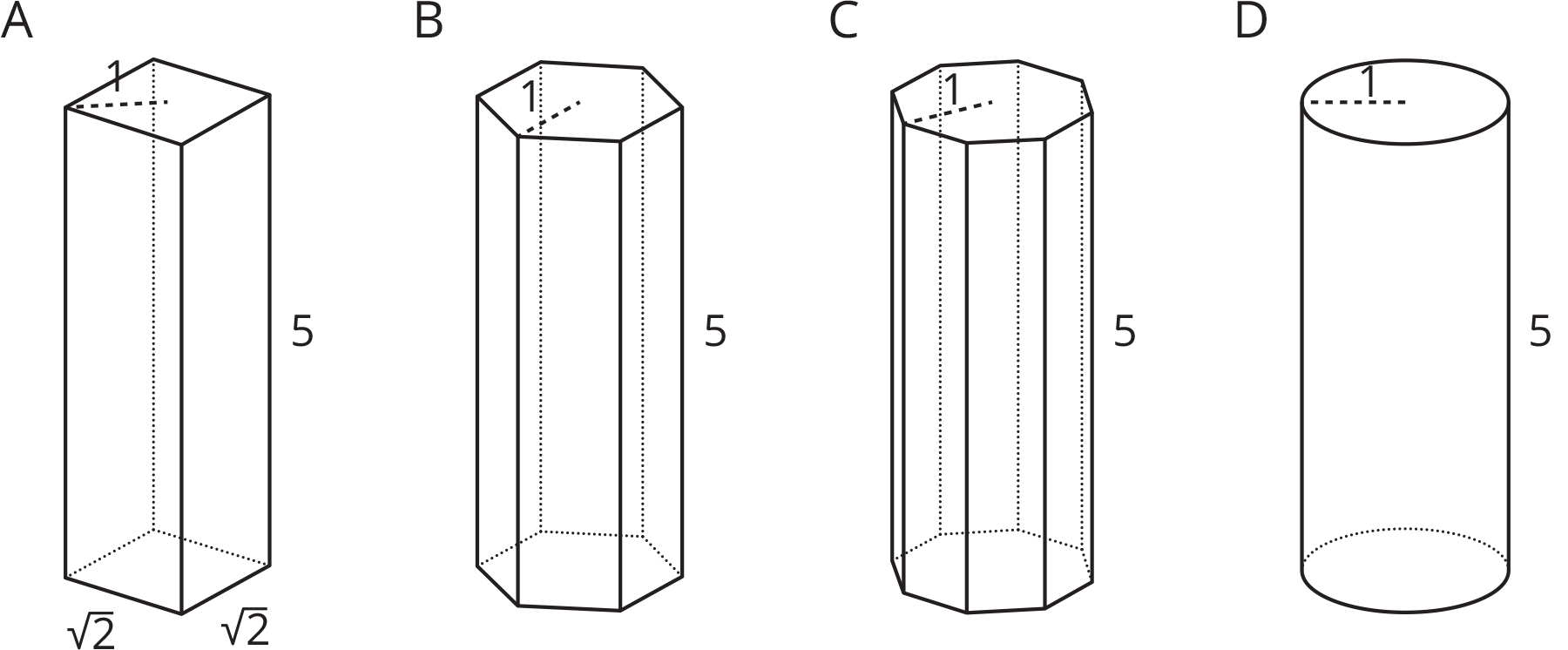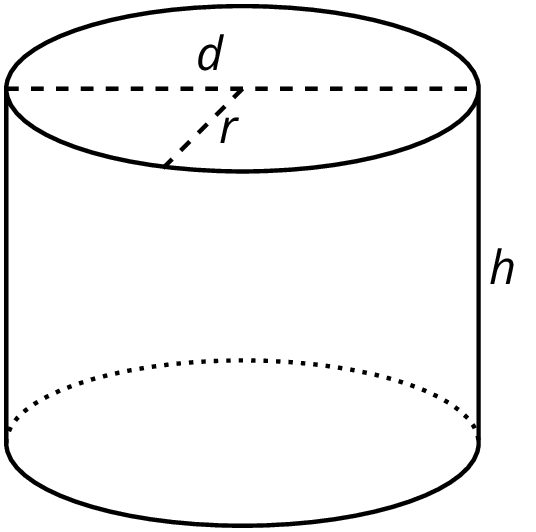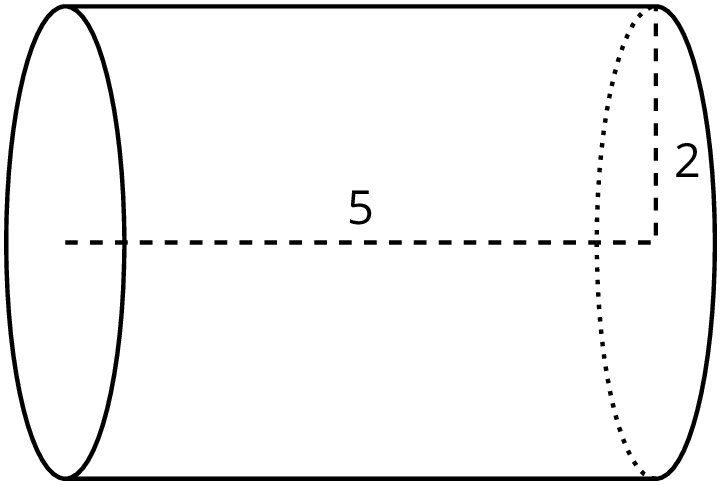Lesson 18
The Volume and Dimensions of a Cylinder
18.1: A Circle's Dimensions (10 minutes)
Warm-up
The purpose of this warm-up is for students to review how to compute the area of a circle. This idea should have been carefully developed in grade 7. This warm-up gives students an opportunity to revisit this idea in preparation for finding the volume of a cylinder later in the lesson.
Students begin the activity with a whole-class discussion in which they identify important features of a circle including its radius and diameter. They use this information and the formula for the area of the circle to choose expressions from a list that are equivalent to the area of the circle. In the final question, students are given the area of the circle and find the corresponding radius.
As students are working, monitor for students who can explain why \(16\pi\), \(\pi 4^2\), and “approximately 50” square units represent the area of the circle.
Launch
Display the diagram from the task statement for all to see and ask students:
- “Name a segment that is a radius of circle A.” (AC, AD, and AB or those with the letters reversed are all radii.) Review the meaning of the radius of a circle.
- “What do we call a segment like BC, with endpoints on the circle that contains the center of the circle?” (A diameter.) Review the meaning of a diameter of a circle.
- “What is the length of segment \(AB\)?” (4 units.) Review the fact that all radii of a circle have the same length.
Give students 3 minutes of quiet work time and follow with a whole-class discussion.
Student Facing

Here is a circle. Points \(A\), \(B\), \(C\), and \(D\) are drawn, as well as Segments \(AD\) and \(BC\).
- What is the area of the circle, in square units? Select all that apply.
- \(4\pi\)
- \(\pi 8\)
- \(16\pi\)
- \(\pi 4^2\)
- approximately 25
- approximately 50
- If the area of a circle is \(49\pi\) square units, what is its radius? Explain your reasoning.
Student Response
For access, consult one of our IM Certified Partners.
Anticipated Misconceptions
If students struggle to recall how to find the area of a circle, encourage them to look up a formula using any available resources.
Activity Synthesis
The purpose of this discussion is to make sure students remember that the area of a circle can be found by squaring its radius and multiplying by \(\pi\).
Select previously identified students to share answers to the first question and explain why each of the solutions represents the area of the circle. If not brought up during the discussion, tell students that sometimes it is better to express an area measurement in terms of \(\pi\). Other times it may be better to use an approximation of \(\pi\), like 3.14, to represent the area measurement in decimal form. In this unit, we will often express our answers in terms of \(\pi\).
Display in a prominent place for all to see for the next several lessons: Let \(A\) be the area of a circle of radius \(r\), then \(A=\pi r^2\).
18.2: Circular Volumes (15 minutes)
Activity
The purpose of this activity is for students to connect their previous knowledge of the volume of rectangular prisms to their understanding of the volume of cylinders. From previous work, students should know that the volume of rectangular prisms is found by multiplying the area of the base by the height. Here we expand upon that to compute the volume of a cylinder.
Students start by calculating the volume of a rectangular prism. Then they extrapolate from that to calculate the volume of a cylinder given the area of its base and its height. If some students don’t know they should multiply the area of the base by its height, then they are prompted to connect prisms and cylinders to make a reasonable guess.
We want students to conjecture that the volume of a cylinder is the area of its base multiplied by its height.
Launch
Arrange students in groups of 2. Remind students that a rectangular prism has a base that is a rectangle, and a cylinder has a base that is a circle. It may have been some time since students have thought about the meaning of a result of a volume computation. Consider showing students a rectangular prism built from 48 snap cubes with the same dimensions as Figure A. It may help them to see that one layer is made of 16 cubes. Give students 3–5 minutes of quiet work time followed by a partner discussion. During their discussion, partners compare the volumes they found for the cylinders. If they guessed the volumes, partners explain their reasoning to one another. Follow with a whole-class discussion.
Supports accessibility for: Visual-spatial processing; Conceptual processing
Student Facing
What is the volume of each figure, in cubic units? Even if you aren’t sure, make a reasonable guess.

- Figure A: A rectangular prism whose base has an area of 16 square units and whose height is 3 units.
- Figure B: A cylinder whose base has an area of 16\(\pi\) square units and whose height is 1 unit.
- Figure C: A cylinder whose base has an area of 16\(\pi\) square units and whose height is 3 units.
Student Response
For access, consult one of our IM Certified Partners.
Student Facing
Are you ready for more?
| prism | prism | prism | cylinder |
| base: square | base: hexagon | base: octagon | base: circle |

Here are solids that are related by a common measurement. In each of these solids, the distance from the center of the base to the furthest edge of the base is 1 unit, and the height of the solid is 5 units. Use 3.14 as an approximation for \(\pi\) to solve these problems.
- Find the area of the square base and the circular base.
- Use these areas to compute the volumes of the rectangular prism and the cylinder. How do they compare?
- Without doing any calculations, list the figures from smallest to largest by volume. Use the images and your knowledge of polygons to explain your reasoning.
- The area of the hexagon is approximately 2.6 square units, and the area of the octagon is approximately 2.83 square units. Use these areas to compute the volumes of the prisms with the hexagon and octagon bases. How does this match your explanation to the previous question?
Student Response
For access, consult one of our IM Certified Partners.
Activity Synthesis
Highlight the important features of cylinders and their definitions: the radius of the cylinder is the radius of the circle that forms its base; the height of a cylinder is the length between its circular top and bottom; a cylinder of height 1 can be thought of as a “layer” in a cylinder with height \(h\). To highlight the connection between finding the area of a rectangular prism and finding the area of a cylinder, ask:
- “How are prisms and cylinders different?” (A prism has a base that is a polygon, and a cylinder has a base that is a circle.)
- “How are prisms and cylinders the same?” (The volume of cylinders and prisms is found by multiplying the area of the base by the height. \(V=Bh\))
- “How do you find the area of the base, \(B\), of a cylinder?” (\(B=\pi r^2\)).
Design Principle(s): Optimize output (for explanation)
18.3: What’s the Dimension? (15 minutes)
Activity
In this activity, students find the missing dimensions of cylinders when given the volume and the other dimension. A volume equation representing the cylinder is given for each problem.
Identify students who use these strategies: guess and check, divide each side of the equation by the same value to solve for missing variable, or use the structure of the volume equation to reason about the missing variable
Launch
Arrange students in groups of 2. Give students 2–3 minutes of quiet work time followed by time to share their explanation for the first problem with their partners.
Supports accessibility for: Memory; Conceptual processing
Design Principle(s): Optimize output (for explanation)
Student Facing
The volume \(V\) of a cylinder with radius \(r\) is given by the formula \(V=\pi r^2h\).
-
The volume of this cylinder with radius 5 units is \(50\pi\) cubic units. This statement is true: \( 50\pi = 5^2 \pi h\)

What does the height of this cylinder have to be? Explain how you know.
-
The volume of this cylinder with height 4 units is \(36\pi\) cubic units. This statement is true: \(36\pi = r^2 \pi 4\)

What does the radius of this cylinder have to be? Explain how you know.
Student Response
For access, consult one of our IM Certified Partners.
Student Facing
Are you ready for more?
Suppose a cylinder has a volume of \(36\pi\) cubic inches, but it is not the same cylinder as the one you found earlier in this activity.
- What are some possibilities for the dimensions of the cylinder?
- How many different cylinders can you find that have a volume of \(36\pi\) cubic inches?
Student Response
For access, consult one of our IM Certified Partners.
Activity Synthesis
Select previously identified students to explain the strategies they used to find the missing dimension in each problem. If not brought up in students’ explanations. Discuss the following strategies and explanations:
- Guess and check: plug in numbers for \(h\), a value that make the statements true. Since the solutions for these problems are small whole numbers, this strategy works well. In other situations, this strategy may be less efficient.
- Divide each side of the equation by the same value to solve for the missing variable: for example, divide each side of \(36\pi=r^2 \pi 4\) by the common factor, \(4\pi\). It’s important to remember \(\pi\) is a number that can be multiplied and divided like any other factor.
- Use the structure of the equation to reason about the missing variable: for example, \(50\pi\) is double \(25\pi\), so the missing value must be 2.
18.4: Cylinders with Unknown Dimensions (15 minutes)
Activity
The purpose of this activity is for students to use the structure of the volume formula for cylinders to find missing dimensions of a cylinder given other dimensions. Students are given the image of a generic cylinder with marked dimensions for the radius, diameter, and height to help their reasoning about the different rows in the table..
While completing the table, students work with approximations and exact values of \(\pi\) as well as statements that require reasoning about squared values. The final row of the table asks students to find missing dimensions given an expression representing volume that uses letters to represent the height and the radius. This requires students to manipulate expressions consisting only of variables representing dimensions.
Encourage students to make use of work done in some rows to help find missing information in other rows. Identify students who use this strategy and ask them to share during the discussion.
Launch
Give students 6–8 minutes of work time followed by a whole-class discussion.
If short on time, consider assigning students only some of the rows to complete.
Supports accessibility for: Organization; Attention
Student Facing

Each row of the table has information about a particular cylinder. Complete the table with the missing dimensions.
| diameter (units) | radius (units) | area of the base (square units) | height (units) | volume (cubic units) |
|---|---|---|---|---|
| 3 | 5 | |||
| 12 | \(108\pi\) | |||
| 11 | \(99\pi\) | |||
| 8 | \(16\pi\) | |||
| 100 | \(16\pi\) | |||
| 10 | \(20\pi\) | |||
| 20 | 314 | |||
| \(b\) | \(\pi \boldcdot b\boldcdot a^2\) |
Student Response
For access, consult one of our IM Certified Partners.
Anticipated Misconceptions
Students might try to quickly fill in the missing dimensions without the proper calculations. Encourage students to use the volume of a cylinder equation and the given dimensions to figure out the unknown dimensions.
Activity Synthesis
Select previously identified students to share their strategies. Ask students:
- “What patterns did you see as you filled out the table?” (Sample reasoning: Rows that had the same base area were easier to compare because their volume was the base area times height.)
- “Look at rows 1 and 3 in the table. How did having one row filled out help you fill out the other more efficiently?” (If the base areas were the same, then the radius and diameter must be the same also.)
- “How did you reason about the last row?”
Design Principle(s): Support sense-making; Optimize output (for justification)
Lesson Synthesis
Lesson Synthesis
Make a display that includes the formula for a cylinder’s volume, \(V=Bh\), along with a labeled diagram of a cylinder. This display should be kept posted in the classroom for the remaining lessons in this unit.
Working in groups of 2, tell students to choose one partner to name a value for the radius and one partner to name a value for the volume of a cylinder. Together, partners determine the height and make a sketch for their cylinder, including labels on the dimensions of their sketch. Display sketches and invite students to share their strategies for determining height.
18.5: Cool-down - Find the Height (5 minutes)
Cool-Down
For access, consult one of our IM Certified Partners.
Student Lesson Summary
Student Facing
We can find the volume of a cylinder with radius \(r\) and height \(h\) using two ideas we've seen before:
- The volume of a rectangular prism is a result of multiplying the area of its base by its height.
- The base of the cylinder is a circle with radius \(r\), so the base area is \(\pi r^2\).
Remember that \(\pi\) is the number we get when we divide the circumference of any circle by its diameter. The value of \(\pi\) is approximately 3.14.
Just like a rectangular prism, the volume of a cylinder is the area of the base times the height. For example, take a cylinder whose radius is 2 cm and whose height is 5 cm.

The base has an area of \(4\pi\) cm2 (since \(\pi\boldcdot 2^2=4\pi\)), so the volume is \(20\pi\) cm3 (since \(4\pi \boldcdot 5 = 20\pi\)). Using 3.14 as an approximation for \(\pi\), we can say that the volume of the cylinder is approximately 62.8 cm3.
In general, the base of a cylinder with radius \(r\) units has area \(\pi r^2\) square units. If the height is \(h\) units, then the volume \(V\) in cubic units is \(\displaystyle V=\pi r^2h\)
It is also true that if we know the volume and one dimension (either radius or height), we can find the other dimension.
For example, imagine a cylinder that has a volume of \(500\pi\) cm3 and a radius of 5 cm, but the height is unknown. From the volume formula we know that
\(\displaystyle 500\pi=\pi \boldcdot 25 \boldcdot h\)
must be true. Looking at the structure of the equation, we can see that \(500 = 25h\). That means that the height has to be 20 cm, since \(500\div 25 = 20\).
Now imagine another cylinder that also has a volume of \(500\pi\) cm3 with an unknown radius and a height of 5 cm. Then we know that
\(\displaystyle 500\pi=\pi\boldcdot r^2\boldcdot 5\)
must be true. Looking at the structure of this equation, we can see that \(r^2 = 100\). So the radius must be 10 cm.